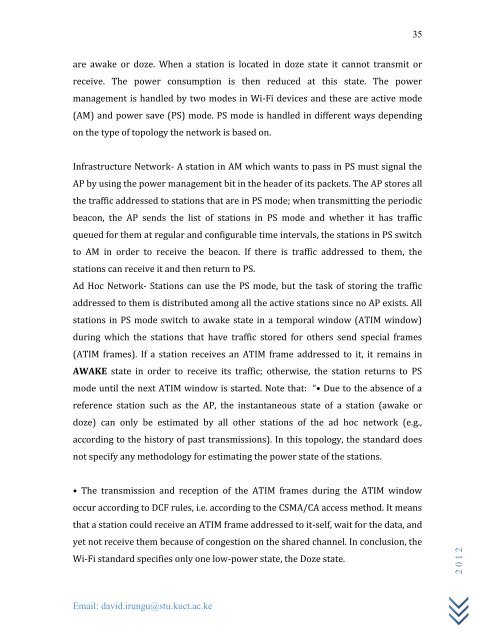SOLAR PV CONTROL SYSTEM.pdf
Create successful ePaper yourself
Turn your PDF publications into a flip-book with our unique Google optimized e-Paper software.
are awake or doze. When a station is located in doze state it cannot transmit or<br />
receive. The power consumption is then reduced at this state. The power<br />
management is handled by two modes in Wi-Fi devices and these are active mode<br />
(AM) and power save (PS) mode. PS mode is handled in different ways depending<br />
on the type of topology the network is based on.<br />
Infrastructure Network- A station in AM which wants to pass in PS must signal the<br />
AP by using the power management bit in the header of its packets. The AP stores all<br />
the traffic addressed to stations that are in PS mode; when transmitting the periodic<br />
beacon, the AP sends the list of stations in PS mode and whether it has traffic<br />
queued for them at regular and configurable time intervals, the stations in PS switch<br />
to AM in order to receive the beacon. If there is traffic addressed to them, the<br />
stations can receive it and then return to PS.<br />
Ad Hoc Network- Stations can use the PS mode, but the task of storing the traffic<br />
addressed to them is distributed among all the active stations since no AP exists. All<br />
stations in PS mode switch to awake state in a temporal window (ATIM window)<br />
during which the stations that have traffic stored for others send special frames<br />
(ATIM frames). If a station receives an ATIM frame addressed to it, it remains in<br />
AWAKE state in order to receive its traffic; otherwise, the station returns to PS<br />
mode until the next ATIM window is started. Note that: “• Due to the absence of a<br />
reference station such as the AP, the instantaneous state of a station (awake or<br />
doze) can only be estimated by all other stations of the ad hoc network (e.g.,<br />
according to the history of past transmissions). In this topology, the standard does<br />
not specify any methodology for estimating the power state of the stations.<br />
• The transmission and reception of the ATIM frames during the ATIM window<br />
occur according to DCF rules, i.e. according to the CSMA/CA access method. It means<br />
that a station could receive an ATIM frame addressed to it-self, wait for the data, and<br />
yet not receive them because of congestion on the shared channel. In conclusion, the<br />
Wi-Fi standard specifies only one low-power state, the Doze state.<br />
Email: david.irungu@stu.kuct.ac.ke<br />
35<br />
2012



